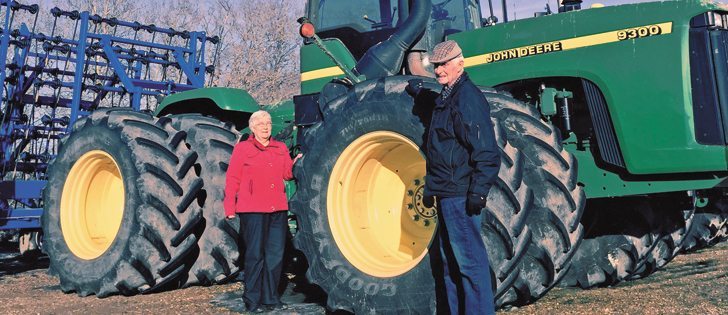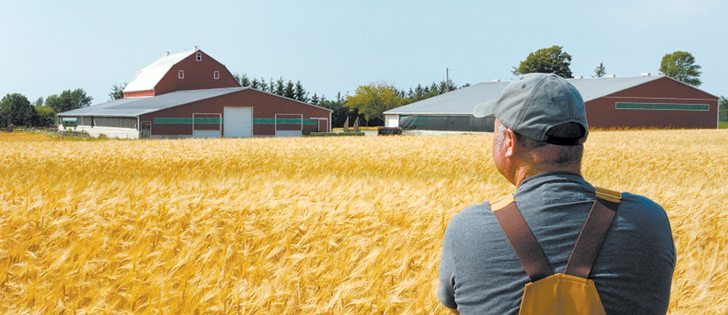You’ve already got the tools and the space to redesign your yard, now you just need some time and a plan
Transforming your farmyard into a landscaped paradise has been on your “to do” list for a number of years. Now that you’ve reached retirement, you’re looking forward to making that dream come true.
James Polley, owner of Allan’s Landscaping in Saskatoon, says there are two important things to remember before landscaping the farmyard:
- Create a design of what it will look like when the makeover is complete.
- Address the drainage issue.
Make sure the land around the house slopes away from the house with a grade of at least two percent. No one wants ponds and puddles where they weren’t intended.
Read Also

Joint tenancy differs from tenancy in common in Sask.
While joint tenancy and tenancy in common both allow co-ownership of a single parcel of land, the impact of each optiondiffers drastically when it comes to estate planning.
Flower beds too close to the house can also create problems. Water applied to the flowers can seep down the sides of the house and pool in tiny pores in the foundation. The water expands as it freezes and creates cracks in the foundation.
Start by applying landscape cloth and seven to 10 centimetres of mulch.
Other stories in this series:
- Finding satisfaction after retirement
- What happens once you’re there (and it’s no fun)
- Saving for children’s education requires a plan
- The pros and cons of buying a condo in the city
Polley recommended crushed rock: the kind that is jagged with rough edges.
“This deters rodents, cats and dogs from walking on it or wanting to dig in it,” he said.
Polley compares landscaping a yard to building a house. Those who are happiest with the final results do a lot of thinking and planning beforehand.
“You don’t just all of a sudden get a bunch of lumber together and start building rooms until you figure it out,” he says.
Also think about who’s going to do the work and how much time they want to devote to it.
“You can almost make this a full-time job,” he says.
“But a beautiful space can be created that requires no more than weekly mowing of the grass and yearly pruning of the shrubs.”
The next step is to establish a budget and then you’re ready to begin designing.
First, define the yard clearly. A farmyard might encompass one, five or even 10 acres, but give it clear borders that can include such elements as fence lines, shrubs and shelter belts.
Next, draw up a design.
A landscape design is like a floor plan for an outdoor area: it creates a visual representation of the yard drawn to scale. It includes trees, flowers, a vegetable garden and grass as well as man-made features such as outdoor furniture, fountains and ponds.
Also include underground electricity, natural gas lines and sewer lines in the drawing. Utility providers can send someone out to flag the locations of these lines.
Once you know what your space looks like, you can start adding and deleting features. Take the time to study some of the different yards in your community. Decide what you like and don’t like. Find out what’s involved in the care of these spaces. Do some research at libraries and on the internet.
Think about your outdoor lifestyle, starting with the house, says Polley.
Now that you are retired and have more time, will you build a deck or build a bigger deck? Will you be entertaining outdoors more, less or about the same as you do now?
How about an east-facing deck or patio where you can linger over a cup of coffee while enjoying the first light of day? Or maybe a cozy bistro table, two chairs and a flower bed or arrangement of potted plants under that maple tree?
You might also consider a solarium.
It can almost be a four season room, even on the Prairies. Ideally, it will be built on to the south side of the house, but it could also work on the east or west exposure.
Decide how many people you want to accommodate in the room, keeping in mind that a solarium can stretch out your enjoyment of the outdoors and provide a great play area for the grandchildren.
“Under-floor heating can make it as nice in there in winter as it is in the middle of summer,” Polley says.
“And today’s triple pane glass can make it a lot easier to heat and more fuel efficient.”
Many farm retirees will have already established shelter belts years ago, but these may be declining or they may have been removed for equipment access.
New shelter belts could include extra rows of trees with varieties that grow slowly up front and fast growing poplars on the outside edges to provide quick results.
Are you thinking of replacing grass with flower beds? Polley’s rule of thumb is, “the more dirt, the more maintenance; the more mulch, the less maintenance.”
Those who want to do less planting should concentrate on turf with areas of mulch around shrubs.
Mulch can be stone or wood, and different colours are available. Apply landscape cloth first. Apply mulch at a good 10 cm with five to seven cm around shrubs.
The yellow potentilla is a shrub that does especially well in Saskatchewan. You may be tempted to pick the white or the prettier pink variety, but the yellow is more drought tolerant.
“It can handle the winds,” says Polley. “The white and pink varieties are slower growing but do better in wet years.”
A common mistake is to plant shrubs too close together, he says.
“If you look at any front of any city house, you see globe or pyramid cedar planted within three feet of the house, and they’re too close.”
To avoid this problem, stand in the spot where you want to plant the shrub with your arms extended and turn in a circle, he says. If your arms hit anything, you’re too close.
Also, look up. If you’re looking at eaves, you need to step away from the house until you’re looking at the sky.
Keep needle-shedding trees and shrubs away from pools and hot tubs.
Most farmers already have the spades, rakes, hoes, tractors, roto tillers and small disk plows that they will need to prepare and maintain their outdoor living space.
Polley says the biggest equipment mistake he sees on farm properties is getting the wrong lawn mower.
“People tend to buy a $6,000 mower that lasts three years instead of a $22,000 machine that will last 20 years, is an easier ride, a nicer mower and does the job in a third of the time,” he says.














